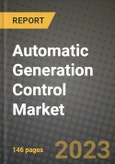The Automatic Generation Control (AGC) market involves systems that automatically regulate the power output of generators in an electrical grid to maintain frequency and balance supply and demand. AGC is crucial for grid stability and reliability. The market is driven by the increasing need for grid modernization and the integration of renewable energy sources.
AGC systems use real-time data from the grid to adjust the output of generators, ensuring that the frequency remains within acceptable limits. These systems can respond to changes in load and generation, maintaining the balance between supply and demand. AGC is essential for managing the variability of renewable energy sources and ensuring grid stability.
The market is seeing advancements in smart grid technologies, which are enabling more sophisticated and responsive AGC systems. The focus is on developing solutions that can integrate with distributed energy resources and provide real-time control. The increasing adoption of renewable energy and the need for grid modernization are driving market growth.
Key Insights - Automatic Generation Control Market
Integration with smart grid technologies and distributed energy resources.Development of advanced control algorithms and optimization techniques.
Rising demand for fast and responsive AGC systems.
Focus on enhancing grid stability and reliability.
Increasing adoption of data analytics and predictive maintenance.
Increasing adoption of renewable energy sources and the need for grid stability.
Growing demand for grid modernization and smart grid technologies.
Rising need for efficient and reliable power supply.
Advancements in control and communication technologies.
Increasing focus on reducing grid losses and improving efficiency.
Integrating diverse energy sources and managing grid complexity.
Ensuring system reliability and preventing grid instability.
Addressing cybersecurity concerns related to grid control systems.
Managing the costs of advanced AGC systems.
Adapting to evolving grid regulations and standards.
Future of the Automatic Generation Control Market - Opportunities and Challenges
Growth momentum is expected to remain strong, propelled by decarbonization initiatives, electrification of transport, modernization of industrial processes, and increasing adoption of digital and automated solutions. The acceleration of renewable integration, grid modernization, and distributed storage is unlocking new applications for Automatic Generation Control technologies. Expanding investments in energy transition, clean mobility, and industrial modernization programs across emerging economies are also key drivers.However, challenges persist. Heightened raw material price volatility, tightening global regulations, supply-demand imbalances, and intense competition pose risks to profitability. Geopolitical uncertainties, trade restrictions, and currency fluctuations further complicate planning. To remain competitive, players must align with sustainability standards, adapt to localized compliance regimes, and manage rising operational costs effectively.
Automatic Generation Control Market Analytics
The report employs rigorous tools, including Porter’s Five Forces, value chain mapping, and scenario-based modeling, to assess supply-demand dynamics. Cross-sector influences from parent, derived, and substitute markets are evaluated to identify risks and opportunities. Trade and pricing analytics provide an up-to-date view of international flows, including leading exporters, importers, and regional price trends.Macroeconomic indicators, policy frameworks such as carbon pricing and energy security strategies, and evolving consumer behavior are considered in forecasting scenarios. Recent deal flows, partnerships, and technology innovations are incorporated to assess their impact on future market performance.
Automatic Generation Control Market Competitive Intelligence
The competitive landscape is mapped through the proprietary frameworks, profiling leading companies with details on business models, product portfolios, financial performance, and strategic initiatives. Key developments such as mergers & acquisitions, technology collaborations, investment inflows, and regional expansions are analyzed for their competitive impact. The report also identifies emerging players and innovative startups contributing to market disruption.Geographic Coverage
- North America: United States, Canada, Mexico
- Europe: Germany, France, UK, Italy, Spain, Rest of Europe
- Asia-Pacific: China, India, Japan, South Korea, Australia, Rest of APAC
- Middle East & Africa: GCC, North Africa, Sub-Saharan Africa
- South & Central America: Brazil, Argentina, Rest of the region
Research Methodology
This study combines primary inputs from industry experts across the Automatic Generation Control value chain with secondary data from associations, government publications, trade databases, and company disclosures. Proprietary modeling techniques, including data triangulation, statistical correlation, and scenario planning, are applied to deliver reliable market sizing and forecasting.Customization Options
The report can be tailored with additional modules such as:- Detailed trade & pricing analytics
- Technology adoption roadmaps and patent analysis
- PESTLE & macroeconomic impact analysis
- Country-specific forecasts and regulatory mapping
- Capital requirements, ROI models, and project feasibility studies
Key Questions Addressed
- What is the current and forecast market size of the Automatic Generation Control industry at global, regional, and country levels?
- Which types, applications, and technologies present the highest growth potential?
- How are supply chains adapting to geopolitical and economic shocks?
- What role do policy frameworks, trade flows, and sustainability targets play in shaping demand?
- Who are the leading players, and how are their strategies evolving in the face of global uncertainty?
Automatic Generation Control Market Segmentation
By Type (Turbine Governor Control, Load Frequency Control), By Component (Hardware, Software, Services), By Application (Hydro Power Plant, Thermal Power Plant, Nuclear Power Plant, Solar Power Plant, Wind Power Plant)This product will be delivered within 1-3 business days.
Table of Contents
Companies Mentioned
- Hitachi Ltd.
- Siemens AG
- GE-Alstom Grid LLC
- General Electric Co.
- Mitsubishi Electric Corp.
- Schneider Electric SE
- Honeywell International Inc.
- ASEA Brown Boveri Ltd.
- Larsen and Toubro Ltd.
- Emerson Electric Co.
- ANDRITZ AG
- Rockwell Automation Inc.
- Wartsila Corp.
- ENERCON GmbH
- Regal-Beloit Corporation
- Hubbell Inc.
- Voith Group
- Yokogawa Electric Corp.
- Woodward Inc.
- OSI Systems Inc.
- Schweitzer Engineering Laboratories Inc.
- DEIF A/S
- Maverick Technologies LLC
- ETAP Operation Technology Inc.
- Suzlon Energy Ltd.








